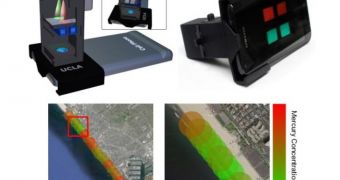Liquid metals are rare, and of them all mercury is the best known and used, and it also happens to be very, very poisonous. Researchers at UCLA have now designed a 3D printed smartphone attachment that checks for it.
You don't need to worry about mercury drops or spills in everyday life. It's not like many people carry around bottles of the thing.
Mercury is used in various devices though, like light bulbs, dry-cell batteries and electrical switches, plus control equipment.
As ironic as it may sound, those things are the ones we have to worry about the least. Mercury-contaminated water is worse.
The hazard is quite large in the vicinity of natural ore deposits and the like, where mercury is found.
The concentration of mercury in water isn't large enough to instantly kill, but it can cause serious issues over time, leading to kidney damage and various other illnesses.
Then there's elemental mercury, released by industrial and agricultural processes, and even household sources, sewage, sediment, etc.
Add to that organic mercury (converted from inorganic mercury by bacteria in surface water), and the tendency that fish have to accumulate it by ingestion (concentration can become 100,000 times higher than in the water), and you have a recipe for disaster (since humans often eat those fish).
Children suffer the worst from both organic and inorganic mercury, as one might guess, since children’s systems more easily absorb it.
Thus, the item invented by researchers from UCLA might find a lot of use by health regulation bodies and water purification system builders, especially in certain areas of the world.
The item is a 3D printed attachment for smartphones which, via an app, can use it to detect mercury in water. It's light, cheap and easy to use, a "lab on a phone" that uses nanoscale gold particles and short fragments of synthetic DNA to detect the presence of mercury ions. Each test takes 20 minutes (10 minutes of "incubation time").
Mercury concentrations down to 3 to 4 parts per billion are picked up (the maximum safe concentration level for drinking water set by the U.S. Environmental Protection Agency and the World Health Organization).

 14 DAY TRIAL //
14 DAY TRIAL //